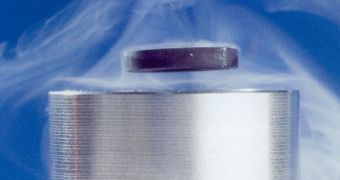Most of the superconducting materials commercially available on the market require cooling to low or very low temperatures to become superconductors, meaning that a special super-cooling equipment is needed in order to operate them. Unfortunately for us, this is the greatest disadvantage of using superconductors. Most of the studies currently conducted in the field of superconductors revolve around high-temperature superconductors, but the University of Saskatchewan Canada Research Chair John Tse claims to have discovered a new family of superconductors which may be operate at room temperature.
The key is in pressure, according to John Tse. It was long suggested that hydrogen could be used as superconductor while being held under high-pressure. But getting hydrogen into a super dense solid state is not as simple as you might think. Alternatively, Tse suggested that we might be able to use the superconductive properties of hydrogen as it is being already incorporated into hydrogen compounds such as hydrides.
"We can show that if you put hydrogen in a molecular compound and apply high pressure, you can get superconductivity. Validation of this hypothesis and understanding of the mechanism are initial steps for design of better super-conducting materials," said Tse.
Superconductive materials have the ability to conduct electricity without suffering the effects of electrical resistance, such as power loss through heating. This means that a current induced into a circular superconducting wire would theoretically loop around it for an infinite amount of time. The advantages of the use of superconducting materials are obvious when considering the power loss through electrical lines, not to mention that it also enables the use of very powerful magnets to levitate and accelerate trains over their tracks, to travel at high speeds without suffering from friction.
The compound chosen for study was silane, a hydrogen-silicon compound. Tse said that the main goal of the study was to improve the critical temperature for superconductivity transition, approximately to that of normal atmospheric temperatures. Upon experimenting with hydrogen, they realized that they did not have the capability of compressing it to enough densities in order to experience transition, and decided to experiment with hydrogen-rich molecules.
Not surprisingly, they reached the required temperature and density to turn the compound into a superconductor, a remarkable achievement in the study of superconductivity. Additionally, Tse's team had been working on studying high-pressure structures of hydrides in the hope to achieve superconductivity and possibly for hydrogen storing for fuel cells.

 14 DAY TRIAL //
14 DAY TRIAL //